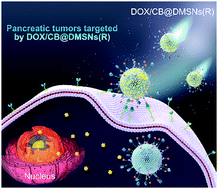Carborane based mesoporous nanoparticles as a potential agent for BNCT†
Abstract
In view of the unique physical and chemical properties, boron rich carboranes have been preliminarily considered as candidates for boron neutron capture therapy (BNCT) in treatment of malignancies. However, before effectively implementing BNCT without damaging the normal cells, great challenges need to be addressed, such as sufficient accumulation of the boron-containing drug at the tumor site, high tumor-to-blood boron ratio and precise targeting. In this study, hydrophilic carborane-based nanoparticles with mesopores, DOX/CB@DMSNs(R), were synthesized. DMSNs(R) refers to dendritic mesoporous silica decorated with PEI-cRGD that could selectively target pancreatic tumor sites overexpressing integrin receptors. Doxorubicin (DOX) as both an anticancer drug and a fluorescence tracer has been well loaded into the mesopores. Such nanoparticles could suppress the leakage of boron into the bloodstream thanks to the covalent bonds, and exhibit outstanding boron loading (ca. 141.5 mg g−1) capacity and sufficient therapeutic dosage delivery (24.4 μg boron atoms g−1 tumor cells). Moreover, these nanoparticles could also selectively deliver boron and DOX to the tumor site. With such nanoparticles an admirable tumor-to-blood boron ratio of 27.1 and a high doxorubicin (DOX) loading (ca. 84.3 mg g−1) have been achieved. We envision that when carefully designed, DOX/CB@DMSNs(R) might serve as a BNCT agent, as well as a carrier of chemotherapy drugs, which could not only precisely target tumor cells, but also safely deliver sufficient drug dosage.



 Please wait while we load your content...
Please wait while we load your content...